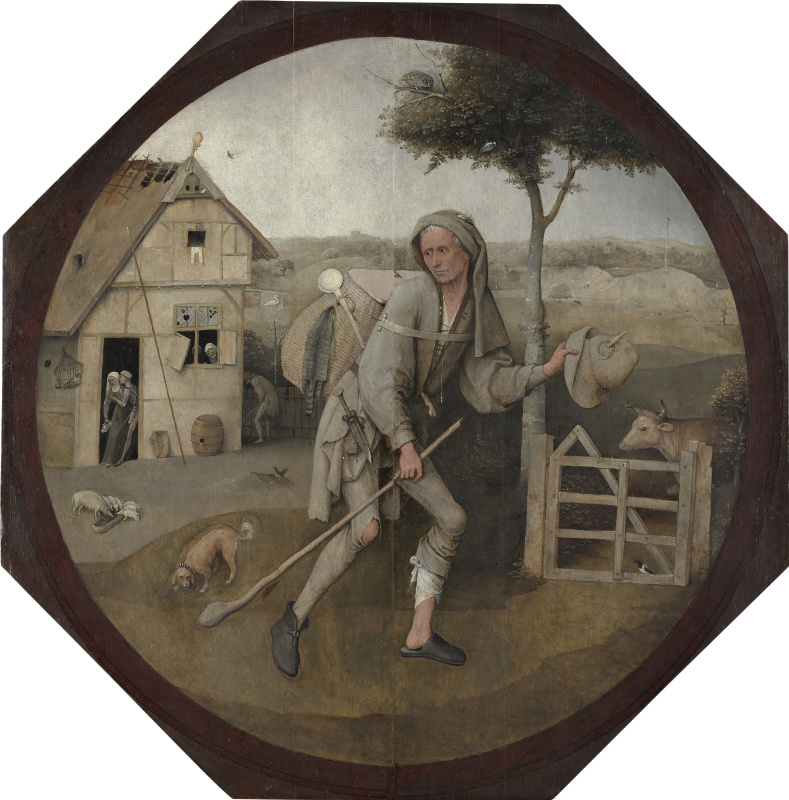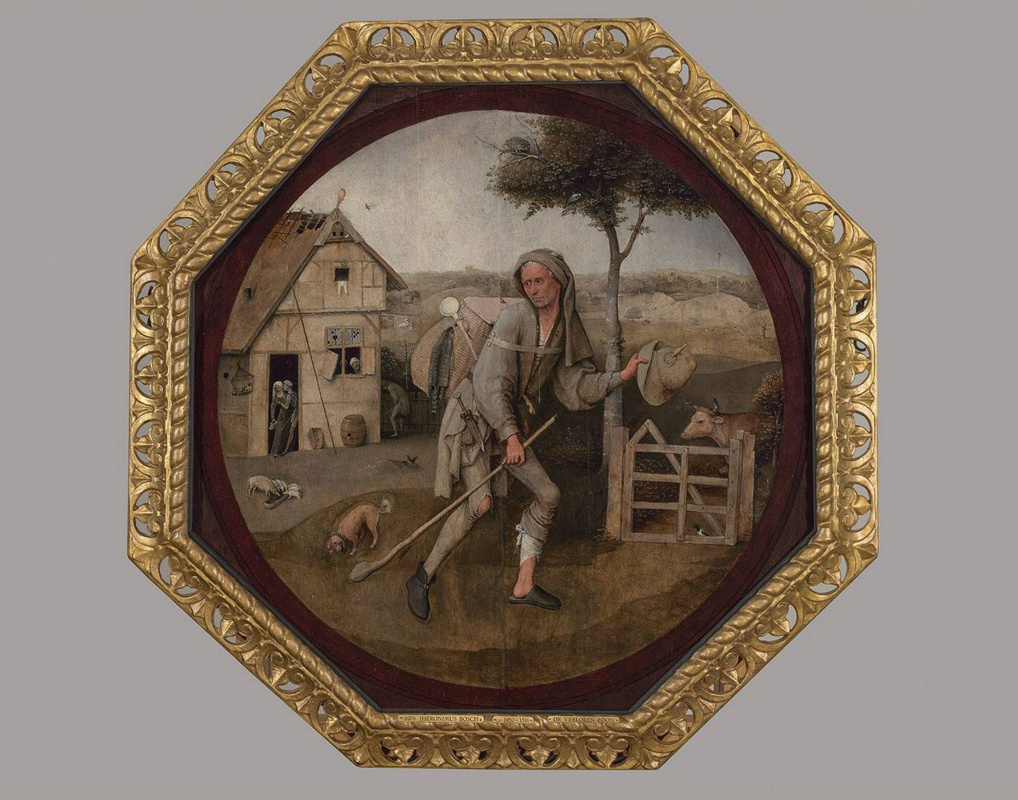log in
Enter site
Login to use Arthive functionality to the maximum
Wanderer
Hieronymus Bosch • Malerei, XVI Jahrhundert, 71×70.6 cm
Bildbeschreibung «Wanderer»
Museum Boymans van Beuningen (Rotterdam) dates "The wanderer" approximately 1500-m year, but bogovidenie highly reputable and steady is the point of view that the painting was created, 10 years, or even 15 later and hence it is one of the last works of Bosch, a kind of final reflection of the artist about his past life.
The image is inscribed in a circle. I believe that originally the painting had a rectangular format which was later converted into an octagonal (presumably in the seventeenth century).
The second title, sometimes applied to the picture – "The prodigal son". It refers to the relevant biblical parable, the iconography of which was made up of three parts: "Leaving home", "Scene in tavern" and "Return to my father's house". However, Bosch does not adhere to this traditional scheme. In the background of the hero really waiting for the tavern, but there is no certainty that the prodigal son, repentant, returns to his father's arms. However, in a spiritual sense every Christian is a pilgrim, a stranger, wandering among hostile realities in search of the lost heavenly homeland.
Travelers-doubles
"The wanderer" from Rotterdam is very similar another traveler by Bosch with external shutters of the triptych "the hay" (Prado, Madrid). But, in the apparent similarity of the Central figures and the General composition, there are significant differences in semantic nuances.
Rotterdam "the wanderer", in comparison with the character of the Madrid triptych, seems to be more broken and more confused. His knee sticking out of the ripped pants, and ankle of the other foot bandaged. It could indicate not only the physical disease: damage to the feet in a symbolic sense, meant debauchery. Distinguished shoes left and right feet, shoes and slipper, indicates promiscuous.
It is unclear what should symbolize the two hats of hero – one at the head and another in his hand. Big straw box behind hints at hardship. To the side of the box attached a large spoon and cat skin, symbols of Vice. Specialists in medieval culture point out that beating a dead cat was considered one of the most shameful punishments.
From the dangers of the temptations
Pilgrim with outer flaps of the "hay" was surrounded by a continuous danger: he threw the dog next over gnawed bones the circling crows, the robbers robbed near the passer, and on the horizon stood the gallows. But the hero of "Wanderer" from Rotterdam moving in the environment is not so hostile. The dog is not aggressive and the stranger does not need to be driven away with staves. Rather, the dog symbolizes libel and slander that accompanies a traveler on life's journey. The landscape in Rotterdam "the Wanderer" contains nothing particularly sinister. On the contrary: it is believed that this is one of the most delicate and beautiful landscapes of Bosch, beige-grey palette which perfectly conveys light and air cloudy Dutch day.
Obvious and grave dangers of "hay" in "the Wanderer" from Rotterdam confront the more subtle spiritual threat of temptation. The major point of attraction for the traveler is getting the tavern. There is no consensus of whether a character from it or fighting with himself to not collapse. But the tavern in the picture is Bosch definitely looks disgusting refuge of brutality, filth and depravity. Her torn roof, broken Windows and rickety shutters are crying about the deviation from healthy lifestyles. Pigs to the trough with food, and chicken on a pile of garbage associated with the visitors hot spots, one of which defecate on view, and two others without embarrassment hug in the doorway. In the hands of women and at the top of the house depicts the pitcher, symbolic "vessel of sin".
Indecisive pose and confused face "Traveler" makes a more logical assumption that he's experiencing an inner struggle and has a chance to avoid temptation, but expected by many researchers is the resemblance of the hero by Bosch allows you to see in the picture is a personal confessional. Kind of pathetic hero makes clear that he is a sinner, but still not completely fallen, like heroes of many eschatological paintings of Hieronymus Bosch, about the end of the world and the last judgment, and having the prospect of salvation. Owl on the tree, a symbol of evil and death, does not sleep and is closely monitoring the traveler. But the peaceful field in front and a cow behind a wooden gate on the right, perhaps is an indication of the correct path and safe return home. "There is even reason to see in this gate and fields that open behind it, some connection with the words of Christ, who in the gospel of John says: "I am the door: if anyone enters by Me, he shall be saved, and shall go in and out, and find pasture" (Jn.10:9)"" writes Walter Bosing, author of the book "Hieronymus Bosch. Between Hell and Paradise."
Author: Anna Yesterday
The image is inscribed in a circle. I believe that originally the painting had a rectangular format which was later converted into an octagonal (presumably in the seventeenth century).
The second title, sometimes applied to the picture – "The prodigal son". It refers to the relevant biblical parable, the iconography of which was made up of three parts: "Leaving home", "Scene in tavern" and "Return to my father's house". However, Bosch does not adhere to this traditional scheme. In the background of the hero really waiting for the tavern, but there is no certainty that the prodigal son, repentant, returns to his father's arms. However, in a spiritual sense every Christian is a pilgrim, a stranger, wandering among hostile realities in search of the lost heavenly homeland.
Travelers-doubles
"The wanderer" from Rotterdam is very similar another traveler by Bosch with external shutters of the triptych "the hay" (Prado, Madrid). But, in the apparent similarity of the Central figures and the General composition, there are significant differences in semantic nuances.
Rotterdam "the wanderer", in comparison with the character of the Madrid triptych, seems to be more broken and more confused. His knee sticking out of the ripped pants, and ankle of the other foot bandaged. It could indicate not only the physical disease: damage to the feet in a symbolic sense, meant debauchery. Distinguished shoes left and right feet, shoes and slipper, indicates promiscuous.
It is unclear what should symbolize the two hats of hero – one at the head and another in his hand. Big straw box behind hints at hardship. To the side of the box attached a large spoon and cat skin, symbols of Vice. Specialists in medieval culture point out that beating a dead cat was considered one of the most shameful punishments.
From the dangers of the temptations
Pilgrim with outer flaps of the "hay" was surrounded by a continuous danger: he threw the dog next over gnawed bones the circling crows, the robbers robbed near the passer, and on the horizon stood the gallows. But the hero of "Wanderer" from Rotterdam moving in the environment is not so hostile. The dog is not aggressive and the stranger does not need to be driven away with staves. Rather, the dog symbolizes libel and slander that accompanies a traveler on life's journey. The landscape in Rotterdam "the Wanderer" contains nothing particularly sinister. On the contrary: it is believed that this is one of the most delicate and beautiful landscapes of Bosch, beige-grey palette which perfectly conveys light and air cloudy Dutch day.
Obvious and grave dangers of "hay" in "the Wanderer" from Rotterdam confront the more subtle spiritual threat of temptation. The major point of attraction for the traveler is getting the tavern. There is no consensus of whether a character from it or fighting with himself to not collapse. But the tavern in the picture is Bosch definitely looks disgusting refuge of brutality, filth and depravity. Her torn roof, broken Windows and rickety shutters are crying about the deviation from healthy lifestyles. Pigs to the trough with food, and chicken on a pile of garbage associated with the visitors hot spots, one of which defecate on view, and two others without embarrassment hug in the doorway. In the hands of women and at the top of the house depicts the pitcher, symbolic "vessel of sin".
Indecisive pose and confused face "Traveler" makes a more logical assumption that he's experiencing an inner struggle and has a chance to avoid temptation, but expected by many researchers is the resemblance of the hero by Bosch allows you to see in the picture is a personal confessional. Kind of pathetic hero makes clear that he is a sinner, but still not completely fallen, like heroes of many eschatological paintings of Hieronymus Bosch, about the end of the world and the last judgment, and having the prospect of salvation. Owl on the tree, a symbol of evil and death, does not sleep and is closely monitoring the traveler. But the peaceful field in front and a cow behind a wooden gate on the right, perhaps is an indication of the correct path and safe return home. "There is even reason to see in this gate and fields that open behind it, some connection with the words of Christ, who in the gospel of John says: "I am the door: if anyone enters by Me, he shall be saved, and shall go in and out, and find pasture" (Jn.10:9)"" writes Walter Bosing, author of the book "Hieronymus Bosch. Between Hell and Paradise."
Author: Anna Yesterday



